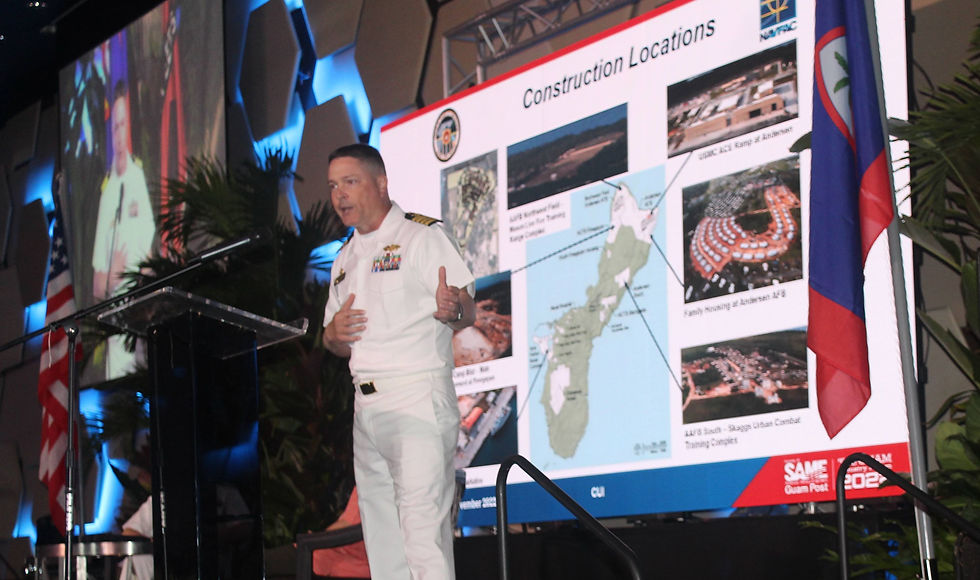Boudra: 'We have to respond from within the theater of operations'
- Admin

- Nov 17, 2022
- 4 min read
$1.2B in annual military construction spending planned for coming years

By Frank Whitman
More than half of the billions of dollars of contracting for the construction of facilities to accommodate the relocation of U.S. Marine units to Guam from Japan has been awarded. However, regional geopolitical tensions have spurred a new regional defense initiative with yet more billions of dollars for construction and related services.
Guam, the Northern Mariana Islands, the Federated States of Micronesia and Palau can expect $1.2 billion to $2 billion of military construction per year for the next seven to eight years, according to Department of Defense officials.
An update and a review of plans for that spending was presented by Navy panelists at the Guam Industry Forum 2022 at Dusit Thani Guam Resort on Nov. 14.
The spending on the Defense Policy Review Initiative – the Marine relocation - peaked during fiscal year 2021 when the Navy awarded 18 projects and 13 contracts valued at $1.45 billion, according to Will Boudra, director of the Guam Program Management Office at Naval Facilities Engineering Systems Command Pacific, and acting director of the recently established Joint Posture Management Office. The GPMO oversees DPRI projects and the JPMO is to oversee work related to the Pacific Deterrence Initiative.
PDI was established in December 2021 to support the National Defense Strategy in response to the “multi-domain threat pose by China,” according to an April 2022 report from the undersecretary of defense (comptroller) about PDI.
The initiative underscores the strategic value of the region. “If we’re going to be a responsive fighting force in the western Pacific, we can’t be responding from the West Coast of the United States,” Boudra said. “It’s too far away; we have to be responding from within the theater of operations.”
Boudra was part of a panel titled “Military Construction Outlook for Guam, the CNMI and Micronesia.” Others on the panel included Capt. Robert Stiles, commanding officer of Officer in Charge of Construction, (OICC) Marine Corps Marianas, and Cmdr. Alan Eichelman, operations officer of NAVFAC Marianas.
More than 350 participants - mostly contractors interested in learning about business opportunities presented by the increase in military activity in the region - attended the three-day forum hosted by the Society of American Military Engineers Guam Post.
Boudra provided an update on DPRI and PDI construction. Currently, in fiscal 2023, the Navy has four active DPRI contract solicitations. They are for a consolidated headquarters, an embarkation facility at Apra Harbor, an infantry facility and family housing. Eight other DPRI projects are expected to be put out for bid later this fiscal year.
DPRI has been in place for more than a decade and Marines are expected to begin moving to Guam by the end of 2024. “Our construction program is spot on,” Boudra said.
Because it is so new, PDI construction projects are mostly in the planning and design stages. These projects include seven airfield design projects – runway, taxiway and lighting – at one location; 15 waterfront projects – boat ramp, dredging, mooring and wharf – in Palau, Yap and Tinian; and one road improvement project between the airport and waterfront in Yap. “We fully expect that we will be making major awards from these designs in fiscal 2025 and forward,” Boudra said.
Stiles provided an overview of the progress of the Marine facilities construction which OICC is executing at six locations on Guam.
The main cantonment of Marine Corps Base Camp Blaz comprises 31 projects valued at $2.2 billion with eight projects to be awarded during fiscal 2023. Three of the construction locations are on Andersen Air Force Base: the Air Combat Element ramp, the Mason Live Fire Training Range Complex and family housing. Another site, the Skaggs Urban Combat Training Complex is utilizing the former Andersen South housing area. Sea embarkation facilities are at Apra Harbor aboard Naval Base Guam.
ADVERTISEMENT
He also pointed out the value NAVFAC places on contractor safety and recognized two Guam contractors – Core Tech-Hawaiian Dredging Construction Co.-Kajima LLC joint venture, and Hensel Phelps – as having particularly strong safety programs. “What I want to brag about is the fact that we have engaged contractors who care about their workers and keep their folks safe while they’re executing the construction program here,” he said. He noted the 5.2 million man hours of construction, multiple work activities every day, 42 projects worth $4.2 billion with no reportable mishaps and no DART cases. “Every contractor on every project is well below the national average (of safety metrics).”
Eichelman noted the enormous opportunities that will accompany the buildup, and the importance of teamwork . “It’s a team effort,” he said. “NAVFAC Marianas cannot do its job; it cannot support the bases, the installations without you in every facet of our business every day.”
He said a new approach is needed as NAVFAC tackles more work in a much larger geographical area with a new sense of urgency. “It’s not work we can afford to get it done as soon as we can get it done,” he said. “It is work we need to award as quickly as possible to get the capability to the warfighter. It’s not just on Guam.”
Subscribe to
our digital
monthly edition







